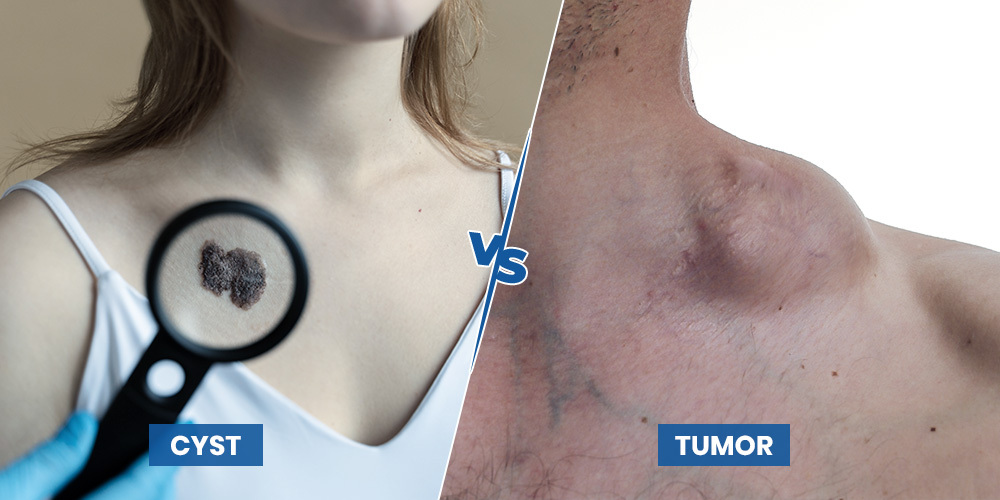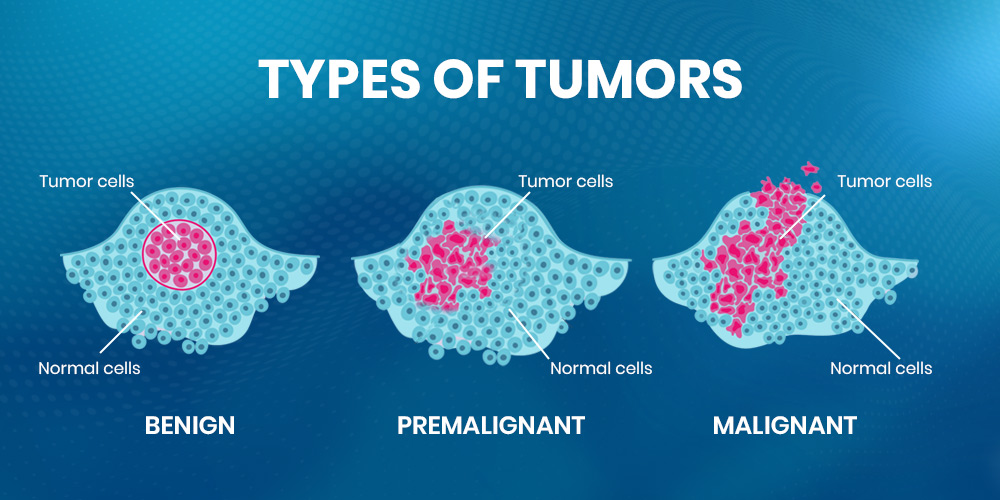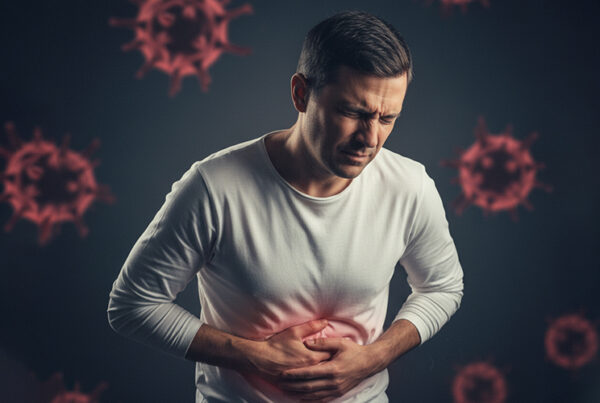
Introduction
When you see a new bump, you might fear that it’s some pre-stage cancerous lump. However, these protrusions might be some small fluid or air-filled sacs called cysts. So, there is confusion between cyst vs tumor.
Additionally, in this blog, we will explore the difference between tumor and cyst, discuss the causes of cysts and types, and how they are diagnosed and treated. Moreover, by the end, you’ll have a clearer understanding of whether you should seek medical attention for a lump.
Cyst vs Tumor: What’s the Difference?
A cyst vs tumor comparison starts with how they develop. A cyst is a sac filled with fluid, air, or semi-solid material, often caused by blockages, infections, or genetic conditions. On the other hand, a tumor is a solid mass of abnormal tissue that may be benign or malignant.
Furthermore, one of the most pressing concerns with tumors is their potential to become cancerous tumors. While cysts generally do not turn into cancer, some tumors can grow and spread aggressively. Therefore, recognizing a cancer lump under skin early is necessary for timely treatment.
What Is a Tumor?
Think of a tumor as a mutation or interruption in the natural process of cell division. When natural cell division is interrupted, there is a mass growth of abnormal cells that are impaired in functioning. This creates a tumor that takes up space and affects the normal functioning of cells. The presence of tumors is not always an indication of cancer. However, your provider will prescribe a biopsy to check for benign growth.
Unlike cysts, tumors tend to be firm, irregular in shape and may grow rapidly. In some cases, tumors can become bulky tumors, requiring aggressive treatment.
Can a Tumor Move?
Tumors are usually fixed and don’t move. On the other hand, cysts can move a bit when pressed. Moreover, the reason for this immobility is that tumors typically seem rooted or fastened because they are tethered to underlying tissues.
Nevertheless, a lump’s mobility does not necessarily indicate whether it is benign or cancerous.
What is a Cyst?
A cyst is a sac-like pocket of tissue filled with fluid, air, or other substances that can develop anywhere in the body. While they can be both small or large, they are not necessarily benign or harmful. Moreover, they may require medical attention if causing discomfort or complications.
Causes of Cyst Formation
The causes of cyst formation vary depending on the type of cyst and its location. Some common causes include:
Blockages: When ducts in the body become blocked, fluid builds up, leading to cysts.
Infections: Bacterial or viral infections can trigger cyst formation.
Inflammatory conditions: Chronic inflammation, such as acne, can cause cysts.
Genetic disorders: Some conditions, like polycystic kidney disease, lead to cyst formation.
Knowing the causes of cysts can help in determining whether a lump is harmless or requires medical attention.
Types of Cysts
Several types of cysts, each with distinct characteristics:
Epidermoid cysts: Small lumps under the skin filled with keratin.
Sebaceous cysts: Develop in oil glands, often on the face or neck.
Ovarian cysts: Fluid-filled sacs that develop in or on the ovaries.
Ganglion cysts: Forms near joints, especially on the wrists.
Baker’s cysts: Swelling behind the knee due to fluid buildup.
Since many types of cysts are benign, they usually do not require treatment unless they cause pain or grow rapidly.
Types of Tumors
Tumors are generally classified into three main types:
- Benign
- Premalignant
- Malignant
Additionally, it’s not always easy to predict how a tumor will behave over time. For instance, a benign tumor could turn cancerous, which is why regular checkups are important. Moreover, if you are diagnosed with a tumor, you can enroll in Ongoing Solid Tumor Clinical Trials to gain multiple benefits.

Benign Tumors
Benign tumors are usually harmless and don’t spread to other parts of the body.
However, they can still cause problems if they press against nerves or blood vessels. If they develop in the endocrine system, they might lead to excessive hormone production.
Premalignant Tumors
Premalignant tumors are not cancerous, but they have the potential to become cancerous if they keep growing. Because of this, doctors monitor them carefully.
Furthermore, there are different types of premalignant tumors. For example, actinic keratosis appears as rough, scaly patches on the skin. Some premalignant tumors, like those on the cervix, may need to be removed using freezing treatments.
Malignant Tumors
Malignant tumors are cancerous and can spread to other parts of the body, making them life-threatening. Moreover, common examples include skin cancer and sarcomas.
Cyst vs Tumor- When To See a Doctor?
The majority of lumps may wait until you see your primary care physician again. From there, you can be sent to an oncologist or dermatologist by your general practitioner.
Nonetheless, you want to make an appointment right once if the protrusion:
- Oozes or bleeds
- Color shifts
- Rapid growth
- Ruptures and Itches
- looks bloated or red.
Furthermore, a doctor can make an accurate diagnosis because they know the difference between a tumor and a cyst. Additionally, visiting a physician lowers your chance of infection, particularly if the growth is bleeding or seeping.
How Can You Determine Whether it’s a Tumor or a Cyst?
Most of the time, a cyst and a tumor cannot be distinguished by their appearance alone. Therefore, to determine if it’s more likely to be a tumor or a cyst, the following chart lists some indicators you might look for.
Moreover, remember that these are not hard-and-fast guidelines and that a tumor and a cyst can occasionally share traits. Furthermore, these symptoms only relate to external tumors; they do not apply to internal organ tumors. It’s essential to consult your physician if you notice or feel anything that worries you.
| Characteristics | Tumor | Cyst |
|---|---|---|
| Rapidly growing | ✔ | |
| Swollen and red | ✔ |
| Characteristics | Tumor | Cyst |
|---|---|---|
| Blackhead in center | ✔ | |
| White, yellow, or green discharge | ✔ | |
| Firmness | ✔ | |
| Tender | ✔ | |
| Mobility under skin | ✔ |
Treatment Options for Tumors and Cysts
The treatment for tumor vs cyst depends on their type, size, and whether they are causing symptoms.
Cyst Treatment
Most cysts do not require treatment unless they become painful or infected. Options include:
Drainage or aspiration: Fluid is removed using a needle.
Medications: Antibiotics or anti-inflammatory drugs may help.
Surgical removal: For cysts that continue to grow or cause discomfort.
Tumor Treatment
Treating tumors depends on whether they are benign or malignant:
Benign tumors: Small ones may be monitored, while larger ones may be removed surgically.
Cancerous tumors: Treatment may include surgery, radiation therapy, chemotherapy, or targeted therapy.
Brain tumor: Often requires specialized treatment, including surgery or radiation.
Moreover, engaging in clinical research trials can provide access to state-of-the-art therapies for people contemplating new treatments.
Also Read: Understanding Pancoast Tumors
Conclusion
To conclude, the difference between tumor and cyst lies in their composition, causes, and potential health risks. While cysts are typically benign and fluid-filled, tumors can be benign or malignant. Identifying a cancerous lump early is crucial for proper treatment.
Engaging in the benefits of clinical research can provide valuable insights into emerging treatments for tumors and other medical conditions. Additionally, NHO Revive is your trusted platform for providing optimal clinical trials with trusted resources and state-of-the-art technology. Participating in Clinical Research Studies will enable you to gain an upper hand in advanced research. Contact us today.
Frequently Asked Questions
How fast do cysts grow?
The growth rate of cysts varies; some grow slowly over months or years, while others may develop quickly.
Is a cyst the same as a tumor?
No, a cyst is a fluid-filled sac, while a tumor is a solid mass of abnormal tissue.
Can a cyst turn into a tumor?
In rare cases, some cysts can develop into tumors, but most remain benign and do not become cancerous.
What is the main cause of cysts?
Cysts can form due to infections, clogged glands, chronic inflammation, or genetic conditions affecting tissue growth.







